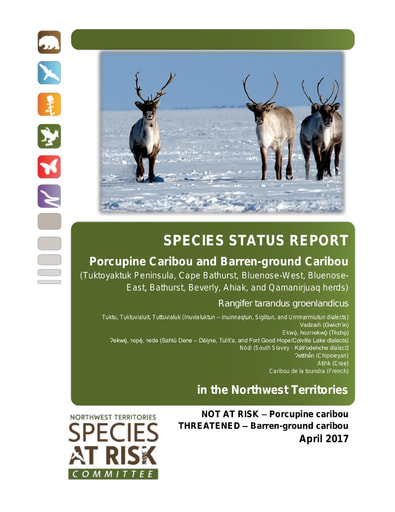pdf 17-04 NWT Barren-Ground Caribou and Porcupine Caribou Status Report-Assessment Popular
By Catarina Owen 4784 downloads
17-04 NWT Barren-Ground Caribou and Porcupine Caribou Status Report-Assessment.pdf

The Northwest Territories Species at Risk Committee met in Fort Smith, Northwest Territories on April 5, 2017 and assessed the biological status of barren-ground caribou and Porcupine caribou in the Northwest Territories (including the Tuktoyaktuk Peninsula, Cape Bathurst, Bluenose-West, Bluenose-East, Bathurst, Beverly, Ahiak, and Qamanirjuaq herds).The assessment was based on this approved status report. The assessment process and objective biological criteria used by the Species at Risk Committee are available at: www.nwtspeciesatrisk.ca.
Barren-Ground Caribou Assessment: Threatened in the Northwest Territories
Likely to become endangered in the Northwest Territories if nothing is done to reverse the factors leading to its extirpation or extinction.
Reasons for the assessment: Barren-ground caribou fit criterion (a) for Threatened.
(a) There is evidence that the population is declining in such a way that it could disappear from the Northwest Territories in our children‘s lifetime.
Main Factors:
- This means that there is a 10% chance that barren-ground caribou could disappear from the Northwest Territories within 75 years.
- Although about 530,000 barren-ground caribou still reside either entirely or partially within the NWT, overall, the numbers have declined by more than 85% for all herds where we have trend information, except the Qamanirjuaq herd, during the past three caribou generations (about 25 years).
- Overall trend demonstrates a continued population decline even though two herds (Cape Bathurst and Bluenose-West) appear to have recently stabilized at very low numbers.
- The main threats are:
- Climate change may act as a continuing threat to barren-ground caribou through a complex mechanism involving shifts in timing of green-up, changes in summer forage quality, rain-on-snow and icing events on the winter range, longer fire seasons, melting permafrost and erosion, changes to freeze-up and thaw timing, and increasing shrub cover. Parasites and diseases are a potential and complex threat under a warmer climate.
- Predation can affect survival and reproduction and therefore abundance, and there are reports of increasing predator populations in some areas.
- Industrial development is considered to be one of the most significant factors affecting barren-ground caribou. It can disturb caribou and affect their behaviour, the quality of habitat and forage, and ultimately, the survivability of the species. It can also facilitate access for both humans and predators.
- Forest fires represent the most visible factor driving habitat fragmentation and change, impacting forage availability and movement. This threat is particularly important in the winter range. Climate change may lead to even hotter and drier summers in the NWT, possibly increasing the frequency and intensity of fires.
Additional Factors:
- Barren-ground caribou populations undergo large fluctuations over several decades. The causes of these fluctuations in abundance are complex and likely driven by climate interacting with forage availability, predation, and parasites. Harvest and predation play a stronger role when barren-ground caribou are at low numbers.
- The threats mentioned above are acting in addition to these large fluctuations. The cumulative effects from multiple interacting threats are considered unprecedented.


 Phone: 867-374-4040
Phone: 867-374-4040 Email:
Email: